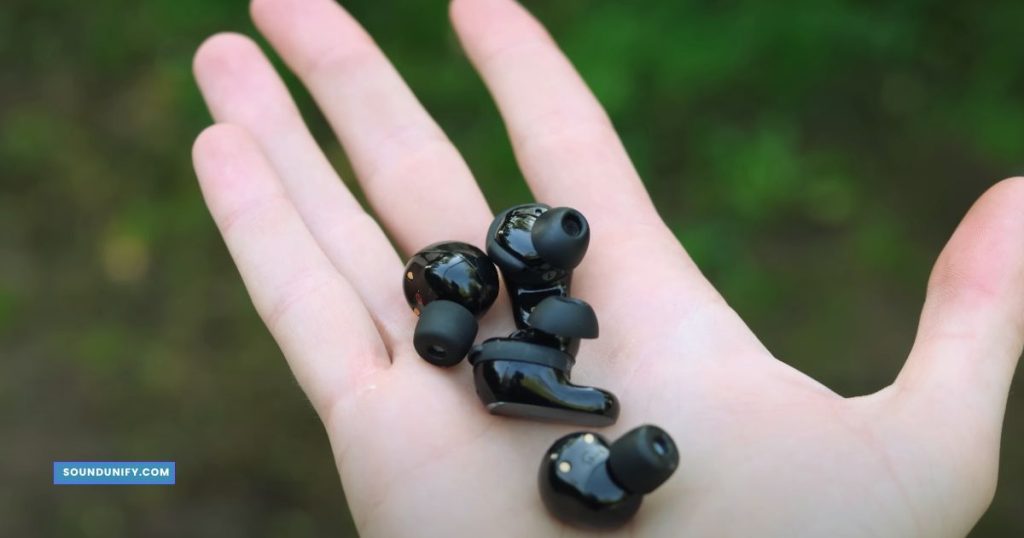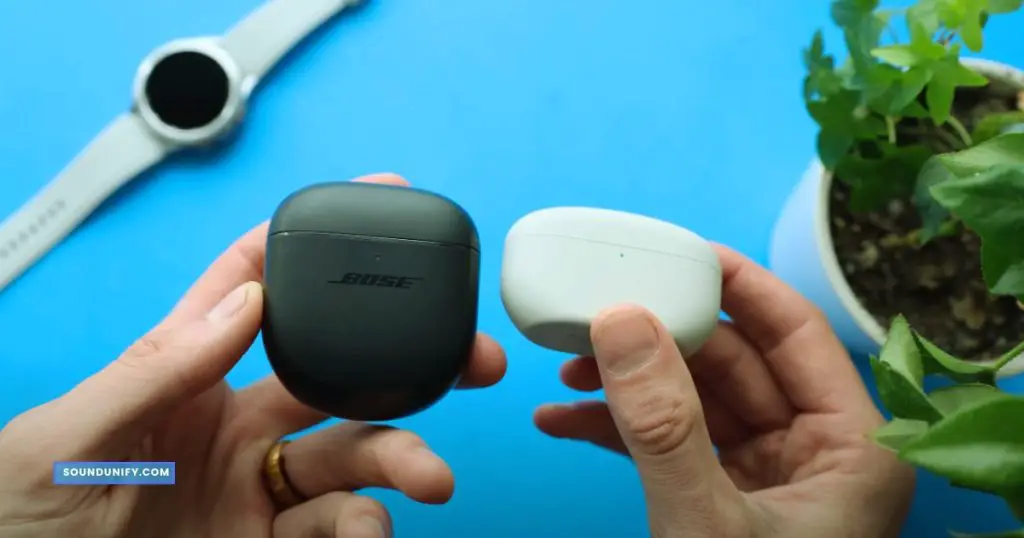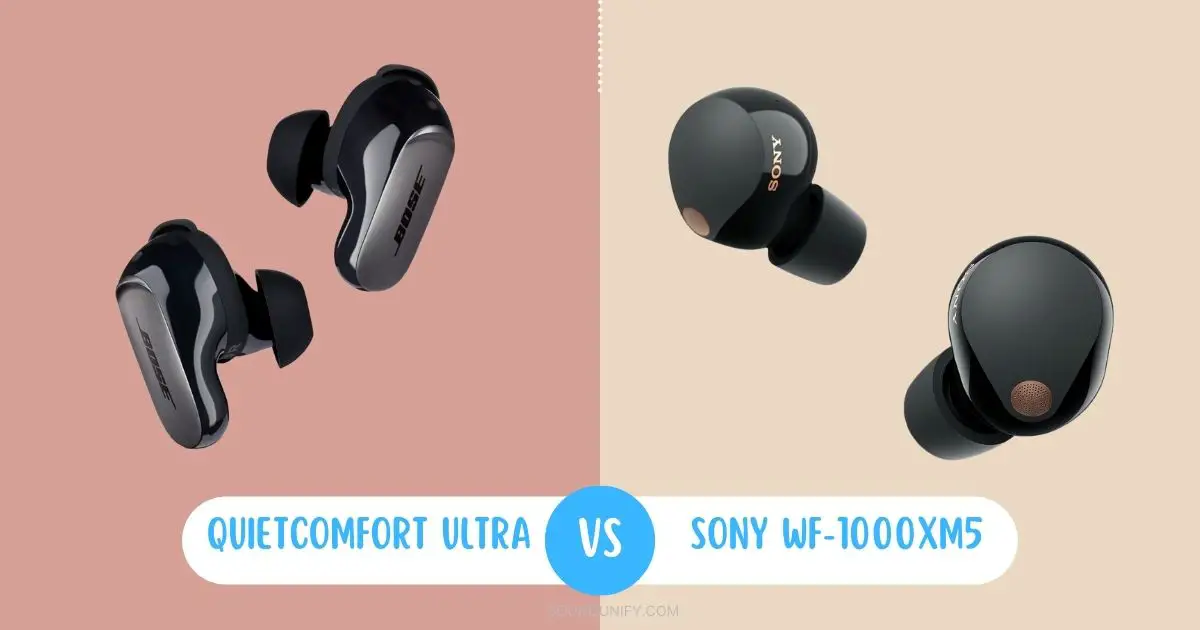Bose QuietComfort Ultra and Sony WF-1000XM5 are like the superheroes of the earbud world, each bringing their own special powers to our ears!
Imagine this: two champions, Bose, entering the scene on October 3rd, 2023, and Sony, making a splash earlier on July 24, 2023, both promising to take our listening adventures to new heights. I’ve spent days lost in the magical worlds they create, with every beat and note telling its own story.
But oh, what a puzzle it is to figure out which one deserves the crown! It’s like choosing between chocolate and vanilla, each so delightful. So, let’s go on a fun musical journey together, exploring every beat, melody, and whisper these little tech wonders bring into our lives.
We’ll dive into their secrets, explore their wonders, and maybe, just maybe, find the perfect sound buddy for our next jam session, movie night, or cozy evening with a good book. Let’s turn the volume up and dance through the details together!
Here's a basic comparison table for the Bose QuietComfort Ultra vs. Sony WF-1000XM5.
| Feature | Bose QuietComfort Ultra | Sony WF-1000XM5 |
|---|---|---|
| Release Date | October 3rd, 2023 | July 24, 2023 |
| Sound Quality | High Quality | Slightly Superior Quality |
| Noise Cancellation | Excellent | Very Good |
| Transparency Mode | Superior | Good |
| Battery Life (Earbuds) | 6-7 hours | 8 hours |
| Battery Life (With Case) | 23-24 hours | 24 hours |
| Wireless Charging | No | Yes |
| Design | Stem Design | Compact Design |
| Weight | 59.8 g (With Case) | 50g (With Case) |
| Water Resistance | [To be verified] | [To be verified] |
| Multi-point Connectivity | No | Yes |
| Codecs | SBC, AAC, APEX Adaptive | SBC, AAC, LDAC |
| Special Features | Spatial audio, ANC | Speak-to-Chat, Quick Listen |
| App Available | Yes | Yes |
| Color Options | Black and White Smoke | Black and Silver |
| Price | Check Price | Check Price |
1. Overview and Design
QuietComfort Ultra Earbuds and Sony WF-1000XM5 are both priced at a premium of under $300. These earbuds have been recognized as top-tier in the market, each excelling in various categories, and have been released relatively recently.
Bose QuietComfort Ultra Earbuds:
- Design: The Bose earbuds have a stem design, which is more visible when worn. They come in two colors: white and black.
- Case: The case for the Bose is notably larger, being almost twice as large or at least one and a half times the size of the Sony case. However, it lacks wireless charging, which is surprising given its size and price point.
- Comfort: These earbuds are described as very comfortable and light in the ears, providing a gentle and relaxing experience, especially during stationary activities like desk work. They come with adjustable wing tips (available in three sizes) and three ear tip sizes.
- Controls: The Bose earbuds feature swipe controls, allowing users to adjust the volume by swiping up and down.
Sony WF-1000XM5:
- Design: The Sony earbuds are more compact and available in white and black colors.
- Case: The case of the Sony earbuds is significantly smaller than the Bose, which is seen as a positive aspect. It also supports wireless charging, which gives it an edge over the Bose earbuds.
- Comfort: The Sony earbuds come with foam ear tips, which provide better passive noise blocking and grip inside the ear, especially during physical activities. However, they might take more effort to insert into the ears than the Bose earbuds.
- Controls: Sony earbuds utilize tap controls, and adjusting the volume requires tapping four times to change one level, which might be seen as a bit tedious.
Comparison Table:
| Feature | Bose QuietComfort Ultra Earbuds | Sony WF-1000XM5 |
|---|---|---|
| Design | Stem design, visible when worn | Compact design |
| Color Options | White Smoke, Black | Silver, Black |
| Case Size | Larger | Smaller |
| Wireless Charging | No | Yes |
| Comfort | Gentle, adjustable wing tips | Foam tips, secure fit |
| Controls | Swipe controls | Tap controls |
2. Sound Quality and Codecs

Regarding Sound Quality and Codecs, both the Bose QuietComfort Ultra Earbuds and the Sony WF-1000XM5 have unique strengths and offerings, providing users with distinct auditory experiences.
Sony WF-1000XM5 has been noted for its robust bass, providing a complete and potentially aggressive sound. That might be particularly appealing to bass enthusiasts. The earbuds come with a feature known as “clear bass,” which allows users to boost the bass to a significantly high level. They provide a massive bass sound across various music genres.
However, it’s worth noting that the Sony earbuds might slightly taper off on the higher frequencies, particularly anything above 5000Hz. That can result in less perceived clarity. Despite this, the Sony earbuds can deliver a more natural sound with the correct EQ settings, even on challenging tracks for earbuds like those by The War On Drugs.
On the other hand, Bose QuietComfort Ultra Earbuds provide a detailed sound profile with a notable attack on snares. They offer a vibrant and dynamic listening experience. The earbuds exhibit more detail in the high hats, providing a more precise and detailed sound than the Sony earbuds.
However, it has been noted that by default, the bass on the Bose earbuds can be overly inflated. This might require users to adjust the EQ settings to their preferences. Additionally, some users might notice artifacts in the left earbud when no audio is playing, potentially impacting the listening experience.
In terms of codecs, both earbuds support SBC and AAC, which are relatively essential, low-level codecs. However, they diverge when it comes to high-resolution codecs. Sony utilizes LDAC, their proprietary codec, which is compatible with numerous Android devices. Unfortunately, iPhone users might miss out on this.
Bose, conversely, employs aptX Adaptive, which is also standard on some Android devices, though perhaps not as widely adopted as LDAC. Users might want to verify the compatibility of their devices with these codecs to ensure optimal sound quality.
Here’s a simplified table for quick reference:
| Feature | Sony WF-1000XM5 | Bose QuietComfort Ultra Earbuds |
|---|---|---|
| Bass Quality | Robust and potentially aggressive with a “clear bass” feature | Detailed but might be inflated by default |
| High-Frequency Clarity | Might taper off above 5000Hz | More precise, especially in high hats |
| Natural Sound | Achievable with the correct EQ settings | Vibrant with notable snares attack |
| Artifacts | Not mentioned | Present in the left earbud |
| Codecs | SBC, AAC, LDAC | SBC, AAC, aptX Adaptive |
Both earbuds have pros and cons regarding sound quality and codec support, and the optimal choice might largely depend on user preference and device compatibility.
3. Noise Cancellation and Transparency

The Noise Cancellation feature provides an immersive listening experience, especially in environments prone to various external noises.
Both Bose QuietComfort Ultra Earbuds and Sony WF-1000XM5 showcase impressive capabilities in this domain, albeit with distinct differences in performance across multiple scenarios.
- Bose QuietComfort Ultra Earbuds: These earbuds have demonstrated substantial efficacy in blocking out white noise, such as the sound of a jet, in set distance tests. They have emerged as the top-performing earbuds in this specific test among all earbuds tested, making them particularly potent in minimizing consistent, low-frequency sounds like airplane noise. However, it’s noteworthy that they exhibit some faint, occasional artifacts and crackling, particularly in the left earbud, in quiet environments.
- Sony WF-1000XM5: While not far behind Bose in the white noise test, Sony’s earbuds have exhibited superior performance in blocking out higher-frequency sounds, such as human voices in crowded rooms or stations, thanks to their foam ear tips. They also maintain a quieter environment in already silent spaces, devoid of the subtle disturbances noted in the Bose earbuds.
Transparency mode is crucial for maintaining awareness of one’s surroundings while enjoying audio content, and the distinction between the two earbuds in this aspect is quite pronounced.
- Bose QuietComfort Ultra Earbuds: They have been lauded for their exceptional transparency mode, estimated to be approximately 40% more effective than Sony’s, providing a natural and unobtrusive audio experience of the surrounding environment. It’s likened to the experience the AirPods Pro delivers, where the user might not even feel like they have earbuds.
- Sony WF-1000XM5: These earbuds, while providing a functional transparency mode, have been described as offering a slightly more muffled and distant sound, with a somewhat robotic tinge to the audio from the surroundings.
Table: Noise Cancellation and Transparency Comparison
| Feature/Aspect | Bose QuietComfort Ultra Earbuds | Sony WF-1000XM5 |
|---|---|---|
| White Noise Cancellation | Excellent (Top-performing) | Very Good (Slightly behind Bose) |
| Voice and High-Frequency Noise Cancellation | Good | Excellent |
| Quiet Environment Maintenance | Good (with minor artifacts in left earbud) | Perfect (Quiet and stable) |
| Transparency Mode | Outstanding (Natural and clear) | Good (Slightly muffled and robotic) |
While Bose excels remarkably in white noise cancellation and transparency mode, Sony pulls ahead in managing high-frequency sounds and maintaining a serene auditory environment when it’s already quiet. The choice between the two might boil down to the specific environments and scenarios users find themselves most often.
4. Features and Connectivity

In Features and Connectivity, the Bose QuietComfort Ultra Earbuds and the Sony WF-1000XM5 bring robust features to the table. Each has unique offerings catering to varied user preferences and requirements.
Sony WF-1000XM5:
- App Personalization: The app offers ear scanning, although it’s not a frequently used feature for the reviewer.
- LE Audio: This feature ensures low latency, which is particularly beneficial for gaming by providing audio and visual synchronization.
- Battery: It provides 8/24 hours of use WITH Active Noise Cancellation (ANC) enabled.
- Quick Charging: A mere 3-minute charge delivers 60 minutes of listening time.
- Multipoint Connectivity: A pivotal feature that allows the earbuds to connect to multiple devices simultaneously, facilitating seamless switching between them.
- Speak to Chat: The music pauses, and transparency mode activates when you start talking, resuming playback when you stop.
- Quick Listen: Users can quickly listen to their surroundings without removing the earbuds by tapping and holding on to the earbud.
Bose QuietComfort Ultra Earbuds:
- Calibration: The earbuds calibrate when placed in the ears.
- Modes in the App: The app allows users to set different modes, adjusting settings like ANC and EQ to suit different environments or activities.
- In-Ear Detection: The earbuds can detect when they are placed in the ears and may alter playback accordingly.
- Battery: Offers 6 hours of use (+18 hours from the charging case).
- Quick Charging: A 5-minute charge provides up to 2 hours of playtime.
- Multipoint Connectivity: Yes, it allows connection to multiple devices.
Both earbuds offer Mono Mode and Spatial Audio, allowing users to use a single earbud when needed and experience a more immersive soundstage. Both also have in-ear detection, which could pause/play media upon inserting or removing the earbuds.
Table: Features and Connectivity Comparison
| Feature | Sony WF-1000XM5 | Bose QuietComfort Ultra Earbuds |
|---|---|---|
| Personalization in App | Yes | Yes |
| LE Audio (Low Latency Gaming) | Yes | Not Mentioned |
| Battery Life (with ANC) | 8/24 hours | 6/24 hours |
| Quick Charging | 3 min charge = 60 min listening | 5 min charge = 120 min listening |
| Multipoint Connectivity | Yes | Yes |
| Speak to Chat | Yes | No |
| Quick Listen | Yes | No |
| Calibration | No | Yes |
| Modes in App | No | Yes |
| In-Ear Detection | Yes | Yes |
| Mono Mode | Yes | Yes |
| Spatial Audio | Yes | Yes |
Both earbuds present a strong case in the features and connectivity domain. The choice between the two may come down to specific feature preferences. If quick listening, speak-to-chat, and slightly longer battery life are crucial for you, Sony might be the way to go. On the other hand, if a simpler app interface, in-ear calibration, and similar battery life are more your speed, Bose might be the preferable option.
5. Battery Life and Charging

In the competitive space of wireless earbuds, Battery Life and Charging capabilities are pivotal factors that can significantly influence purchasing decisions. The Sony WF-1000XM5 and the Bose QuietComfort Ultra Earbuds bring commendable battery performance, each with merits and minor shortcomings.
Sony WF-1000XM5:
- Advertised Battery Life: Sony claims an impressive 8 hours of continuous playback with noise canceling activated, and this extends to a total of 24 hours when factoring in the additional charges provided by the case.
- Fast Charging: While exact fast charging details weren’t specified, fast charging capabilities are present.
- Wireless Charging: The case supports Qi wireless charging, providing an additional convenience for users who already utilize wireless charging pads.
Bose QuietComfort Ultra Earbuds:
- Estimated Battery Life: While Bose doesn’t provide exact figures, reviews indicate that the QuietComfort Earbuds Ultra can deliver around 6-7 hours of continuous playback per charge, with the case providing an additional 16 hours.
- Fast Charging: A brief 5-minute charge in the case provides approximately 2 hours of use, ensuring users can quickly get back to their listening experience after a short charging period.
- Wireless Charging: Unfortunately, Bose does not offer wireless charging with this model, which might be a missed opportunity given the case size.
Table: Battery Life and Charging Comparison
| Feature | Sony WF-1000XM5 | Bose QuietComfort Ultra Earbuds |
|---|---|---|
| Battery Life (ANC On) | 8 hours (24 with case) | 6-7 hours (24 with case) |
| Fast Charging | Yes | Yes (2 hours from 15 min charge) |
| Wireless Charging | Yes | No |
6. Call Quality
In an outdoor environment with a breeze and traffic in the background, the call quality of the Sony WF-1000XM5 and Bose QuietComfort Earbuds Ultra is tested.
Sony WF-1000XM5:
- The microphone test outdoors presented a scenario with noticeable traffic noise.
- The specific quality and clarity of the microphone in this environment are not explicitly detailed in the available information.
Bose QuietComfort Earbuds Ultra:
- The microphone test was also conducted outdoors amidst traffic.
- Detailed insights regarding the microphone quality in this scenario are not provided in the available information.
Without explicit commentary or detailed analysis of the available information, it’s challenging to determine a clear winner regarding call quality. Both earbuds were tested in a difficult environment.
Alternatives to Consider
Beyond the flagship Bose and Sony noise-canceling earbuds compared here, there are some alternative options worth considering:
- Apple AirPods Pro 2 – Apple’s latest earbuds offer strong ANC, great transparency mode, and seamless iOS integration. It’s not multipoint, but it’s ideal for iPhone owners.
- Samsung Galaxy Buds 2 Pro – These new earbuds from Samsung have adjustable ANC and work great with Galaxy devices. It’s more affordable than Sony and Bose too.
- Anker Soundcore Liberty 4 – The $150 Soundcore Liberty 4 provides surprisingly decent active noise cancellation with app EQ for budget shoppers.
- Beats Fit Pro – With a sporty wingtip design, Beats Fit Pro delivers punchy sound and ANC for workouts. Integrate nicely with iPhones.
The Bottom Line
Choosing between premium noise-canceling wireless earbuds comes down to your budget, platform ecosystem, and listening priorities. The Sony WF-1000XM5 stands out as the top overall package right now.
But Bose QuietComfort Earbuds Ultra still performs excellently for travel ANC and iOS users. Read detailed reviews before buying, and try selecting earbuds from stores with generous return policies in case they don’t meet your audio needs.
James Dimento is a Chief-in-Editor of SoundUnify. He is a headphone enthusiast and creative writer passionate about audio technology. He has three years of experience writing about headphones and sound quality and is responsible for creating reviews and taking care of all administration.
